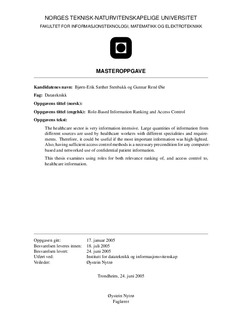| dc.description.abstract | This thesis presents a formal role-model based on a combination of approaches towards rolebased access control. This model is used both for access control and information ranking. Purpose: Healthcare information is required by law to be strictly secured. Thus an access control policy is needed, especially when this information is stored in a computer system. Roles, instead of just users, have been used for enforcing access control in computer systems. When a healthcare employee is granted access to information, only the relevant information should be presented by the system, providing better overview and highlighting critical information stored among less important data. The purpose of this thesis is to enable efficiency and quality improvements in healthcare by using IT-solutions that address both access control and information highlighting. Methods: We have developed a formal role model in a previous project. It has been manually tested, and some possible design choices were identified. The project report pointed out that more work was required, in the form of making design choices, implementing a prototype, and extending the model to comply with the Norwegian standard for electronic health records. In preparing this thesis, we reviewed literature about the extensions that we wanted to make to that model. This included deontic logic, delegation and temporal constraints. We made decisions on some of the possible design choices. Some of the topics that were presented in the previous project are also re-introduced in this thesis. The theories are explained through examples, which are later used as a basis for an illustrating scenario. The theory and scenario were used for requirement elicitation for the role-model, and for validating the model. Based on these requirements a formal role-model was developed. To comply with the Norwegian EHR standard the model includes delegation and context based access control. An access control list was also added to allow for patients to limit or deny access to their record information for any individual. To validate the model, we implemented parts of the model in Prolog and tested it with data from the scenario. Results: The test results show rankings for information and controls access to it correctly, thus validating the implemented parts of the model. Other results are a formal model, an executable implementation of parts of the model, recommendations for model design, and the scenario. Conclusions: Using the same role-model for access control and information ranking works, and allows using flexible ways to define policies and information needs. | nb_NO |
